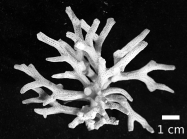
| Intro | | About | | Wiki | | Search traits | | Data explorer | | Literature | | Definitions | | Sources | | Webservices | | Statistics | | Feedback | | Editors | | Log in |
WoRMS taxon detailsSeriatopora Lamarck, 1816
205121 (urn:lsid:marinespecies.org:taxname:205121)
accepted
Genus
marine,
Lamarck, [J.-B. M.] de. (1816). <i>Histoire naturelle des animaux sans vertèbres</i>. Tome second, 566 pp. Paris, Verdière. , available online at http://www.biodiversitylibrary.org/item/47698 [details]
Description Colonies form compact bushes with anastomosing branches. Corallites are arranged in neat rows along the branches; they are...
Description Colonies form compact bushes with anastomosing branches. Corallites are arranged in neat rows along the branches; they are mostly immersed and have poorly developed internal structures except for a solid style-like columella; usually one, sometimes two cycles of septa, and fused to the columella. Coenosteum covered by fine spicules. Polyps extended only at night (Veron, 1986). [details]
Hoeksema, B. W.; Cairns, S. (2025). World List of Scleractinia. Seriatopora Lamarck, 1816. Accessed through: World Register of Marine Species at: https://www.marinespecies.org/aphia.php?p=taxdetails&id=205121 on 2025-07-16
Date action by 2000-09-28 07:24:50Z changed Garcia, Maria
Nomenclatureoriginal description
Lamarck, [J.-B. M.] de. (1816). <i>Histoire naturelle des animaux sans vertèbres</i>. Tome second, 566 pp. Paris, Verdière. , available online at http://www.biodiversitylibrary.org/item/47698 [details] basis of record Veron JEN. (1986). Corals of Australia and the Indo-Pacific. <em>Angus & Robertson Publishers.</em> [details] Otheradditional source
Veron JEN, Pichon M. (1976). Scleractinia of Eastern Australia. Part I. Families Thamnasteriidae, Astroceoniidae, Pocilloporidae. <em>Australian Institute of Marine Science Monograph Series.</em> 1: 1-86. [details]
additional source Randall RH. (2003). An annotated checklist of hydrozoan and scleractinian corals collected from Guam and other Mariana Islands. <em>Micronesica.</em> 35-36: 121-137. page(s): 127 [details] additional source Robertson R. (1970). Review of the predators and parasites of stony Corals, with special reference to symbiotic Prosobranch Gastropods. <i>Pacific Science 24 (1)</i>: 43-54 page(s): 46, 48 [details] additional source Veron JEN. (2000). Corals of the World. Vol. 1–3. <em>Australian Institute of Marine Science and CRR, Queensland, Australia.</em> [details] additional source Duncan PM (1884) A revision of the families and genera of the sclerodermic Zoantharia, Ed. & H., or Madreporaria (M. Rugosa excepted). Journal of the Linnean Society of London, 18: 1-204. [details] additional source Brüggemann, F. (1877). Notes on the stony corals in the collection of the British Museum. I. Description of two new species of Turbinariidae. II. Remarks on the species of Seriatopora. <em>Annals and Magazine of Natural History, Series 4.</em> 19: 415–421. [details] additional source Verrill AE. (1869). Synopsis of the polyps and corals of the North Pacific Exploring Expedition, under Commodore C. Ringgold and Capt. John Rodgers, U.S.N., from 1853 to 1856. Collected by Dr. Wm. Stimpson, Naturalist to the Expedition. <em>Communications of the Essex Institute, Salem.</em> 6 (1): 51-104, pls. 1-2., available online at https://doi.org/10.1086/270634 page(s): 100-101 [66-67] [details] additional source Gohar, H.A.F. (1940). Studies on the Xeniidae of the Red Sea: their ecology, physiology, taxonomy and phylogeny. <em>Publications of the Marine Biological Station, Ghardaqa (Red Sea).</em> 2: 25-118, plates 1-7. page(s): 76, 108 [details] additional source Verrill, A. E. (1868-1870). Review of the corals and polyps of the west coast of America. <em>Transactions of the Connecticut Academy of Arts and Sciences.</em> 1, 6, 377-558. page(s): 513, 519 [details] additional source Dunn, D. F. (1982). Cnidaria. McGraw-Hill Book Company. New York and other cities., volume 1, pp. 669-706 page(s): 701 [details]  Present Present  Inaccurate Inaccurate  Introduced: alien Introduced: alien  Containing type locality Containing type locality
Unreviewed
Description Colonies form compact bushes with anastomosing branches. Corallites are arranged in neat rows along the branches; they are mostly immersed and have poorly developed internal structures except for a solid style-like columella; usually one, sometimes two cycles of septa, and fused to the columella. Coenosteum covered by fine spicules. Polyps extended only at night (Veron, 1986). [details]Remark Type species: Seriatopora subulata Lamarck, 1816 from the West Indies (Veron, 1986). [details] |

